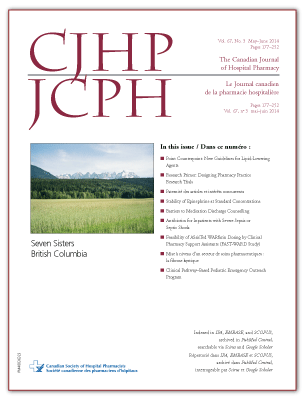Time to Administration of Antibiotics among Inpatients with Severe Sepsis or Septic Shock
DOI:
https://doi.org/10.4212/cjhp.v67i3.1358Keywords:
antibiotics, severe sepsis, septic shock, timing, antibiotiques, sepsis sévère, choc septique, rapidité d’interventionAbstract
ABSTRACT
Background: Current evidence suggests that administration of appropriate antibiotic therapy within 1 h after the onset of hypotension significantly improves mortality rates among patients with severe sepsis and septic shock.
Objectives: To determine the interval from recognition of severe sepsis or septic shock in inpatients to initial administration of antibiotic and to assess institutional compliance with the Surviving Sepsis Campaign’s recommendation for early antibiotic therapy.
Methods: A 6-month retrospective chart analysis was conducted to determine the interval from documented onset of hypotension to initial administration of antibiotic for patients with severe sepsis or septic shock. Patients who were admitted to a general medicine ward, a surgery ward, or the intensive care unit (ICU) of a 475-bed university-affiliated hospital and who met the criteria for severe sepsis or septic shock were eligible for inclusion. Patients who received antibiotics before meeting the criteria for severe sepsis or septic shock were excluded.
Results: Charts for 100 patients with severe sepsis or septic shock were reviewed. The mean age was 69.0 years (standard deviation 18.7 years), and 56% were men. The median interval from onset of severe sepsis or septic shock to administration of antibiotic was 4.00 h (interquartile range [IQR] 1.80–6.45 h). The median interval from the time a physician ordered an antibiotic to administration of the drug was 1.28 h (IQR 0.57–3.05 h). The interval between ordering and administration differed significantly for patients on the wards (5.67 h), those with onset in the ICU (4.00 h), and those with onset in the emergency department (3.28 h) (p = 0.039). The overall survival rate was 56%.
Conclusion: At the study hospital, the interval from onset of severe sepsis or septic shock to initial administration of antibiotic to inpatients exceeded the 1-h period recommended by the Surviving Sepsis Campaign. These results will be used as a baseline for future quality assurance and improvement initiatives aimed at minimizing the time to antibiotic administration for this group of patients, who are at high risk of death.
RÉSUMÉ
Contexte : D’après les données probantes actuelles, l’administration d'une antibiothérapie adéquate dans l’heure suivant la survenue d’hypotension aide grandement à réduire le taux de mortalité chez les patients atteints de sepsis sévère ou de choc septique.
Objectifs : Déterminer quel est l’intervalle séparant le diagnostic du sepsis sévère ou du choc septique de l’administration initiale d’un antibiotique aux patients hospitalisés et évaluer le degré de conformité de l’établissement envers la recommandation de la campagne « Surviving Sepsis » (survivre au sepsis) qui préconise une antibiothérapie précoce.
Méthodes : Une analyse rétrospective couvrant six mois de dossiers médicaux a été effectuée dans le but de déterminer l’intervalle entre la survenue consignée de l’hypotension et l’administration initiale d’un antibiotique chez des patients atteints de sepsis sévère ou de choc septique. Les patients qui étaient admis à un service de médecine générale ou de chirurgie ou à l’unité de soins intensifs (USI) d’un hôpital universitaire de 475 lits et qui répondaient aux critères d’un sepsis sévère ou d’un choc septique étaient admissibles à l’étude. Ceux qui ont reçu des antibiotiques avant de satisfaire aux critères d’un sepsis sévère ou d’un choc septique ont été exclus.
Résultats : Les dossiers médicaux de 100 patients atteints de sepsis sévère ou de choc septique ont été étudiés. L’âge moyen était de 69,0 ans (écart-type de 18,7 ans) et 56 % des patients étaient des hommes. L’intervalle médian entre le moment du diagnostic d’un sepsis sévère ou d’un choc septique et celui de l’administration d’un antibiotique était de 4,0 h (écart interquartile [ÉIQ] de 1,80 à 6,45 h). L’intervalle médian entre le moment où le médecin prescrivait un antibiotique et l’administration de celui-ci était de 1,28 h (EIQ de 0,57 à 3,05 h). L’intervalle entre le moment de la prescription et celui de l’administration était beaucoup plus important pour les patients chez qui un sepsis sévère ou un choc septique apparaissait alors qu’ils se trouvaient au service de chirurgie ou de médecine générale (5,67 h) que pour les patients qui étaient à l’USI (4,00 h) ou au service des urgences (3,28 h) (p = 0,039). Le taux de survie global était de 56 %.
Conclusion : À l’hôpital où s’est déroulée l’étude, l’intervalle entre les premières manifestations d’un sepsis sévère ou d’un choc septique et le moment où l’antibiotique était administré aux patients excédait la période d’une heure recommandée par la campagne « Surviving Sepsis » (survivre au sepsis). Ces résultats serviront de référence pour de futurs programmes d’amélioration et d’assurance de la qualité dont l’objectif sera de réduire au maximum la période de temps située entre le diagnostic et l’administration de l’antibiotique pour ce groupe de patients qui présente un risque élevé de mortalité.
Downloads
Published
Issue
Section
License
Copyright © Canadian Society of Healthcare-Systems Pharmacy.
After publication of a manuscript in the CJHP, the authors of the manuscript must obtain written permission from the CSHP (publications@cshp.ca) before reproducing any text, figures, tables, or illustrations from the work in future works of their own. If a submitted manuscript is declined for publication in the CJHP, all said rights shall revert to the authors. Please note that any forms (e.g., preprinted orders and patient intake forms) used by a specific hospital or other health care facility and included as illustrative material with a manuscript are exempt from this copyright transfer. The CJHP will require a letter from the hospital or health care facility granting permission to publish the document(s).










